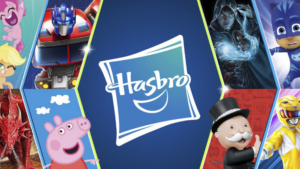Navigating the Toy Market: Hasbro’s Strategy for Supply Chain Diversification
In the ever-evolving landscape of the global market, companies are constantly seeking ways to adapt and thrive amidst economic pressures. Recently, Hasbro’s CEO, Chris Cocks, provided insights into how the toy giant is navigating these challenges during a candid interview with CNBC’s Jim Cramer. At Extreme Investor Network, we delve deeper into this strategy and explore its implications for investors, suppliers, and consumers alike.
Shifting Gears: A Move Towards Diversification
Cocks revealed that Hasbro is accelerating its efforts to diversify its supply chain, particularly in response to the steep tariff hikes imposed during the Trump administration. "Our goal was to get to about 40% of global sourcing out of China by the end of 2026, and I think we’ll hit that much earlier," he confidently stated.
This proactive approach sees Hasbro expanding its manufacturing footprint beyond China to countries such as the U.S., Turkey, Japan, India, Vietnam, and Indonesia. The company has already successfully relocated several hundred stock-keeping units (SKUs) this year alone, showcasing a commitment to strengthening its supply chain resilience.
Why Diversification Matters
For investors, understanding Hasbro’s diversification strategy is crucial. The toy and entertainment industry operates on thin margins, making supply chain vulnerabilities like tariffs particularly impactful. By reducing dependence on a single country, Hasbro is positioning itself to mitigate risks related to geopolitical factors and tariffs—an essential move for long-term sustainability.
Balancing Expertise and Accessibility
While Hasbro is diversifying its supply sources, Cocks acknowledged the ongoing significance of Chinese manufacturing. "China is always going to be an important place for us to source product," he emphasized, citing the country’s specialized labor force and expertise in producing high-quality toys and electronics.
This dual approach—leveraging established production capabilities while exploring new markets—might be a savvy play for businesses looking to balance cost and quality in an increasingly competitive landscape.
The Price of Toys: An Economic Consideration
Cocks also addressed the potential financial repercussions of tariffs, forecasting a possible $300 million hit to Hasbro’s bottom line if current duties remain in place. Interestingly, he believes that their diversified supply chain could soften the blow. “I expect prices to go up, but our sourcing flexibility might allow us to keep increases lower than our competitors.”
The market dynamics indicate that while prices may rise, Hasbro is committed to keeping core items—especially giftable products—within the $10 to $20 range, which is vital for consumer accessibility during holiday seasons.
Understanding Consumer Behavior
At Extreme Investor Network, we emphasize the importance of grasping consumer sentiment in investment decisions. For many families, toys represent an essential purchase, and maintaining a budget-friendly price point can influence buyer loyalty. Hasbro’s strategy to keep popular items affordable demonstrates a keen understanding of its customer base and the broader economic climate.
Looking Ahead: Market Adaptability
Hasbro’s strategic moves reflect a broader trend among businesses seeking to become more adaptable in uncertain times. As the political landscape and trade policies evolve, Cocks mentioned that they anticipate future changes in tariffs and regulations. “Trade policy remains a pretty fluid situation,” he noted, highlighting the need for agility in business operations.
Takeaway for Investors: The toy market, though competitive, presents opportunities for long-term investment, particularly in companies like Hasbro that are embracing adaptability and strategic foresight. As consumers navigate the landscape of rising prices, organizations that focus on product quality while maintaining affordability will likely emerge as market leaders.
Conclusion
As we continue to monitor the shifts in the economy and consumer markets, Hasbro serves as an instructive example of how to adapt and innovate amidst challenges. The company’s focus on supply chain diversification not only positions it for growth but also offers crucial lessons for investors seeking insight into market resilience.
At Extreme Investor Network, we remain dedicated to providing unique insights and valuable information to empower your investment strategies. Stay informed, stay engaged, and let us guide you through the complexities of today’s financial landscape.

